Author: Caroline Jones (BPhty – Registered Physiotherapist)
Exercise can be one of the most effective treatments for lymphedema, especially in the arm where swelling can have a significant impact on activities of daily living.
As one of the four main treatments of lymphedema (along with compression, lymphatic drainage and skin care,) exercise can help to strengthen and mobilise the arm and shoulder girdle, increasing the ability to deal with the daily load suffered by lymphedema patients.
Does Exercise Help Arm Lymphedema?
Historically, lymphedema patients were warned against exercising their affected limb however further research into this area has produced promising results.
Correctly prescribed exercise can be used to help prevent lymphedema in those patients who are high risk, and also help reduce swelling in those patients with established symptoms.
The Physical Activity and Lymphedema (PAL) Trial(1) is a randomized controlled exercise intervention trial that took place in Pennsylvania.
295 breast cancer survivors were recruited; 141 presented with lymphedema while 154 were classified as at risk for lymphedema.
The study showed that not only was strength training safe in these patients, but it could help manage and prevent worsening of symptoms.

What Is The Best Type of Exercise to Do For Arm Lymphedema?
Exercise can be broken down into three different categories:
1) Resistance/Strength Training
2) Cardiovascular Training
3) Flexibility Training – Stretching
Resistance Training
Resistance exercise is an important but often neglected part of lymphedema treatment.
The muscles of the body act as a pump to drain lymphatic fluid.
Traditionally, weight training was avoided by patients at risk of developing swelling, but research has shown that not only is it safe, but it can help prevent lymphedema or at least limit the severity of symptoms if experienced.
Building lean muscle mass on a limb can increase the efficiency of the inbuilt muscle pump.
While there’s no need to start body building in a bid to resemble Arnold Schwarzenegger, strength training with even the lightest of weights can help achieve the desired outcome.
Cardiovascular Training
Also known as aerobic training, cardio is an important part of every fitness regime.
It especially plays a part in general health and weight loss (or management,) which is a key factor in the management or prevention of lymphedema.
Research has shown that overweight and obese patients are more likely to develop lymphedema than patients in a healthy weight range.

An article published in the Journal of Plastic Reconstructive Surgery (2) reviewed evidence from several research studies and found that obesity lead to an increased risk of developing primary and post-operative lymphedema.
Even if you are unable to lose weight, you should avoid sudden significant weight gain.
Flexibility/Stretching
Many patients who have had surgery or radiotherapy for breast cancer will have adhesions and restricted range of movement from scarring.
Scar tissue can cause “roadblocks” where fluid can’t drain across.
This makes stretching a very important element to implement in an exercise regime.
10 Exercises To Reduce And Prevent Arm Lymphedema
1/ Shoulder Rolls
This is a great exercise to start off a routine as it helps to loosen up the shoulder joints and facilitate good posture.
Circle the shoulders in one direction for 10 repetitions before switching to 10 in the opposite direction.
Combine with deep breathing which helps with relaxation as well as stimulating the lymphatic duct, the main collecting channel in the abdomen.
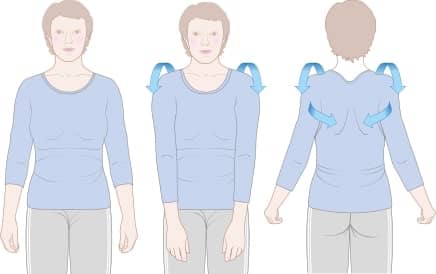
2/ Neck Stretches
Having a heavy arm can cause compensatory postural changes so make sure you don’t neglect your neck and back.
Tilt your head to one side, reaching your ear to your shoulder, you should feel a stretch down the opposite side of your neck.
Return to the middle and then repeat on the other side. Perform this stretch three times on each side, holding each attempt for 10-30 seconds.
3/ Shoulder Front Raises
With straight elbows, slowly raise your arms out in front to shoulder height before returning them back to the starting position.
This movement should be smooth and controlled.
To progress, hold light hand weights or any household item such as water bottles or tins of food.
4/ Shoulder Lateral Raises
Very similar to front raises but this time, slowly raise your straight arms out to side.
Only lift to shoulder height as any higher can risk shoulder impingement.
Again, to make this exercise harder, add weights.
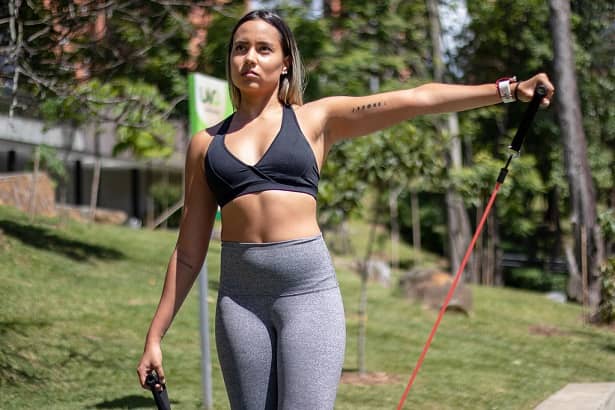
5/ Roof Punches
Start with both hands at shoulder height and gently punch up towards the roof, alternating hands.
Use light hand weights or just start with empty hands and clenched fists.
6/ Boxing
A great combined cardio and strength training exercise.
There are several options, try either shadow boxing where you punch an invisible target, pillow boxing or using a punching bag if you have access to one.
Mix it up with a variety of hooks, upper cuts and jabs and make sure you use both arms.
7/ Bicep Curls
One of the simplest exercises you can do, using hand weights bend your elbows so your hands come up to your shoulders.
If you don’t have access to any weights, use tins of food, water bottles or other household objects.
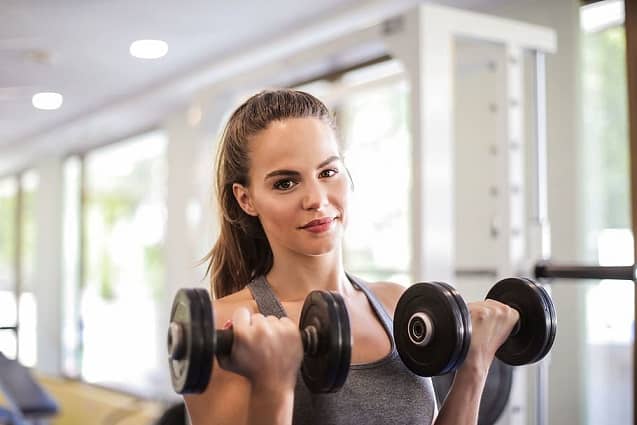
8/ Wall Push Ups
This is an especially useful exercise for patients who have had surgery for breast cancer as they can often have tightness across the chest muscles.
Place your hands on the wall in front of you, approximately shoulder width apart.
Keeping your core muscles engaged, bend your elbows and lower your chest towards the wall before pushing your elbows back straight.
9/ Twinkle, Twinkle
This movement targets your hands and gets the fluid pumping from the hand and fingers, commonly a stubborn area.
Clench your fist and then open the hand up, repeat several times. It is even more effective if you perform this with your hand elevated.
10/ Hands Up Wall
Standing in front of the wall walk your fingers up until you feel a stretch through the axilla (the armpit) and down the side of the trunk.
It can also be done with your arm out to the side.
Place a mark or take note of where you reach each time and try and improve each time
The above exercises can all be done at home or in the gym.
An audit published in the Journal of Lymphoedema(3) found that attending a weekly exercise class not only improved or maintained limb volumes in a group of Breast Cancer Related Lymphedema (BCRL) patients but also resulted in an increase in quality of life.
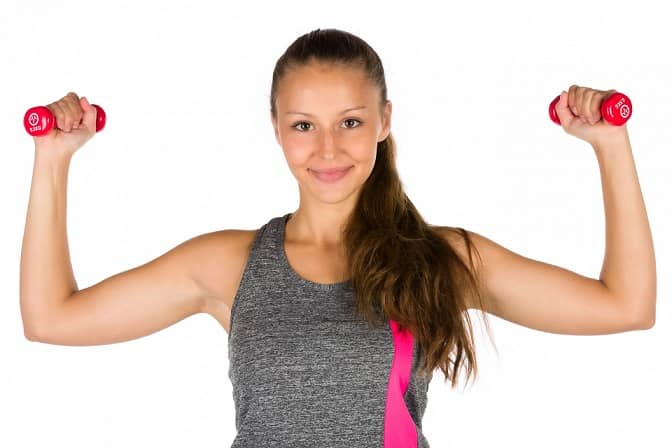
Things to consider while exercising:
1/ Compression Garments – Make sure you wear your compression garment, this will add to the muscle pump to assist drainage
2/ Overload – Avoid overloading the arm or performing too many repetitive movements
3/ Skin Care – Wear sunscreen and insect repellent if you’re outside. Sunburn and insect bites increase the risk of infections
4/ Clothing – Avoid wearing tight or restrictive clothing. Also make sure to wear a supportive, well-fitting sports bra, especially if performing high impact exercise such as jogging or aerobics
5/ Posture – Be mindful of your posture, a heavy arm can cause rounded shoulders and sore neck muscles. These muscle imbalances can further aggravate pain
7/ Warning Signs – Look out for signs of increased swelling, heaviness as well as new aches and pains, seek advice from an appropriate health professional if you’re concerned.
8/ Appropriate Exercise Prescription
Conclusion
We hope this article helped you understand the benefits of exercise for arm lymphedema.
There are a range of arm exercises available to help lymphedema, and even a small amount of exercise done daily can lead to a huge difference in your health.
If you wish to learn more about leg exercises which help Lymphedema, check out our article here.
Check out lymphedemalifeline.org for more articles like this.
References
- Schmitz, K. H., Troxel, A. B., Cheville, A., Grant, L. L., Bryan, C. J., Gross, C. R., Lytle, L. A., & Ahmed, R. L. (2009). Physical Activity and Lymphedema (the PAL trial): assessing the safety of progressive strength training in breast cancer survivors. Contemporary clinical trials, 30(3), 233–245.
- Mehrara, B. J., & Greene, A. K. (2014). Lymphedema and obesity: is there a link? Plastic and reconstructive surgery, 134(1), 154e–160e.
- Bracha, Jillian & Jacob, Tamar. (2010). Using exercise classes to reduce arm lymphoedema. Journal of Lymphoedema. 5. 46-55.
Disclaimer – The information on this website is for informational purposes only. Lymphedemalifeline.org and it’s staff, writers, etc. assumes no responsibility for any consequences arising from any use made of, or any reliance on, the information contained on this website.

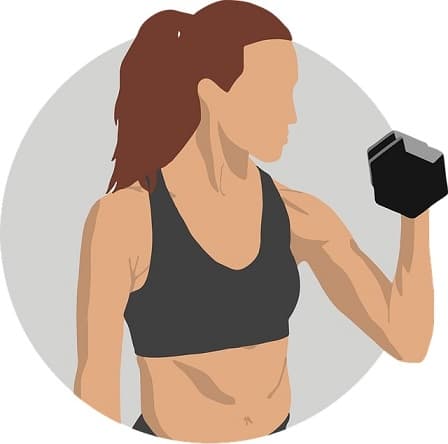
Please let me know if I am able to receive a copy of this article, the exercises appear to be very helpful. thank you. Judy
Hi Judy, I’d be happy to send you an electronic copy if that would help? You can use the contact form under ‘contact us’ at the top to request this, thanks
I have a Vebo pump for my legs, I need a sleeve. for my arm. can I use the pump I have and can I use it for an arm sleeve.
I am not familiar with that device Peter sorry, I would suggest you contact the maker to discuss this.